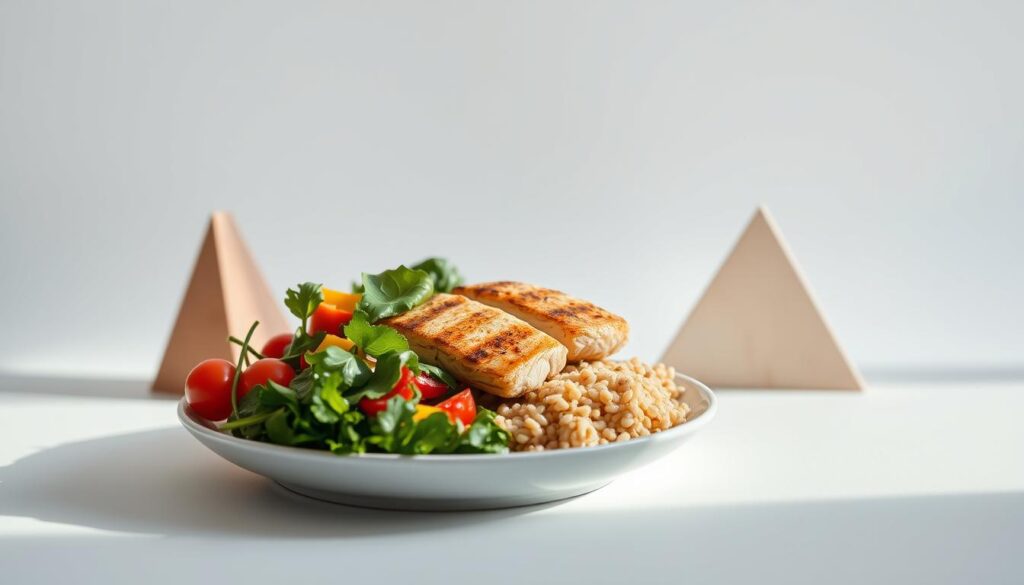Why [Diet] is the Best Choice for Weight Loss
Table of Contents
Have you ever felt stuck in a cycle of diet attempts that never work? I felt defeated, trying many weight loss plans that promised quick fixes but left me hungry and sad. The Mediterranean diet changed my life, offering a healthy way to change my body and health.
Experts say successful weight loss isn’t about quick fixes. It’s about making healthy, balanced food choices. The Mediterranean diet is a great way to lose weight and get healthier, research shows.
This diet isn’t about cutting out foods you love. It’s about eating whole foods, lean proteins, and healthy fats. Studies show people on the Mediterranean diet lose more weight than those on low-fat diets. They’re also more likely to keep the weight off for a year or more.
Key Takeaways
- Mediterranean diet offers sustainable weight loss approach
- Supports long-term health beyond weight management
- Emphasizes whole foods and balanced nutrition
- Reduces risk of chronic diseases
- Provides flexible and enjoyable eating plan
Understanding Weight Loss Fundamentals
Weight loss is a complex journey that requires understanding key scientific principles. Your body’s ability to shed pounds depends on multiple factors, including nutrition, metabolism, and healthy eating strategies.
The Science Behind Caloric Deficit
Creating a caloric deficit is the cornerstone of weight loss. The Centers for Disease Control and Prevention confirms that weight reduction occurs when you burn more calories than you consume. This fundamental principle means you need to:
- Track your daily calorie intake
- Reduce caloric consumption
- Increase physical activity
A strategic approach involves cutting approximately 500 calories daily, which can lead to losing one pound per week. Consistency is key in maintaining this deficit.
To get better results, you can benefit from the benefits of this nutritional supplement
Role of Metabolism in Weight Management
Your metabolism plays a crucial role in weight loss. Muscle tissue burns more calories at rest, making strength training an essential component of your nutrition plan. Engaging in resistance exercises for 20 minutes twice weekly can help maintain muscle mass during weight reduction.
| Metabolic Factor | Impact on Weight Loss |
|---|---|
| Muscle Mass | Increases resting calorie burn |
| Sleep Duration | 7-9 hours helps regulate hunger hormones |
| Protein Intake | 25-30% of daily calories supports metabolism |
Basic Principles of Healthy Weight Loss
Successful weight management combines nutrition, exercise, and lifestyle modifications. Consider these fundamental guidelines:
- Aim for 150 minutes of moderate-intensity exercise weekly
- Consume a balanced diet with adequate protein
- Practice mindful eating
- Get sufficient sleep
Remember, sustainable weight loss is a marathon, not a sprint. Focus on creating lasting healthy habits that support your long-term wellness goals.
Why Diet Matters More Than Exercise

Your diet is more important for weight loss than exercise. Studies show that 80% of weight loss comes from what you eat. Only 20% comes from working out.
Looking into how diet affects weight loss shows some interesting facts:
- A single venti Green Tea Frappuccino has about 520 calories
- Cycling for one hour burns around 525 calories
- Creating a 500-calorie daily deficit is easier with diet
“Weight loss is fundamentally about creating a caloric deficit, and it’s much easier to cut calories through diet than to burn them through exercise.”
Focus on what you eat to lose weight more effectively. Diets full of whole foods, lean proteins, and fiber help you lose weight. They make you feel full and cut down on calories.
| Dietary Approach | Weight Loss Impact |
|---|---|
| Whole Foods Diet | More effective for sustainable weight loss |
| Processed Food Diet | Hinders weight loss progress |
| High-Protein Diet | Preserves muscle mass during weight loss |
While exercise is key for health, your diet drives weight loss. A mix of small calorie cuts and smart nutrition can lead to more weight loss than exercise alone.
Key Components of a Successful Weight Loss Diet
To lose weight, you need to know the key nutrients that help you stay healthy. It’s not just about counting calories. It’s about eating foods that give you energy and support your body.

Your diet should have important elements for lasting weight loss and health. Let’s look at the main parts that can change your diet for the better.
Protein: Your Weight Loss Ally
Protein is key for feeling full and keeping muscle. The National Weight Control Registry says to eat high-quality protein:
- Lean meats like chicken and turkey
- Fish rich in omega-3 fatty acids
- Plant-based proteins such as legumes and tofu
- Low-fat dairy products
Fiber: The Satiety Superstar
Foods high in fiber are great for weight control. They make you feel full and help control hunger. Studies show that foods like fruits, veggies, and whole grains help with weight loss.
Healthy Fats: Essential for Success
Not all fats are good. Healthy unsaturated fats from avocados, nuts, and olive oil help with weight loss and heart health.
| Food Group | Recommended Daily Intake | Weight Loss Benefits |
|---|---|---|
| Protein | 0.8-1.2g per kg of body weight | Increases metabolism, reduces appetite |
| Fiber | 25-30g | Promotes fullness, supports digestive health |
| Healthy Fats | 20-35% of daily calories | Supports hormone function, reduces inflammation |
Successful weight loss means having a diet that’s good for your body and helps you reach your goals.
Creating Sustainable Eating Habits
Building sustainable eating habits is key to lasting weight loss. Your diet should be a long-term plan, not just quick fixes. By making nutrition enjoyable, you can change how you view food.
Here are some tips for lasting healthy eating:
- Fill half your plate with vegetables to get more nutrients
- Choose whole grains like quinoa and brown rice over refined ones
- Add lean proteins to keep your muscles strong
- Use smaller plates to control how much you eat
Think about your diet for the long haul, not just today. Sustainable eating means picking foods that give you energy for a long time. Nutrition experts say choose whole, unprocessed foods for the best health benefits.
Drinking enough water is also important. Try to drink at least 8 cups a day, depending on how active you are and where you live. Cutting down on sugary drinks can help you avoid extra calories and stay hydrated.
Sustainable eating is about making choices that are good for you and the planet.
By following these tips, you’ll make a diet that feels good, not restrictive. The best diet is one you can stick to and enjoy every day.
Exercise and Physical Activity Support
Successful weight loss needs more than just eating right. Exercise is key to your weight loss journey and health. The right mix of diet and exercise can change your body and boost your metabolism.

Your exercise plan should fit your fitness level. The Centers for Disease Control and Prevention say adults should do at least 150 minutes of moderate-intensity aerobic activity weekly. This helps with weight loss and keeps you healthy.
Combining Diet with Exercise
Exercise and healthy eating together are a strong weight loss strategy. Your workout should match your diet, helping you:
- Burn extra calories
- Build lean muscle
- Boost your metabolism
- Get fitter overall
Best Types of Exercise for Weight Loss
Not all exercises are good for losing weight. Here are some effective ones:
- High-Intensity Interval Training (HIIT) – Burns lots of calories fast
- Strength training – Builds muscle and increases metabolism
- Cardiovascular exercises – Good for heart health and fat burning
- Low-impact activities like swimming or cycling
Activity Guidelines for Optimal Results
“The best exercise is the one you’ll actually do consistently.” – Fitness Expert
For lasting weight loss, pick exercises you like and can keep up with. Older adults should aim for 150 minutes of moderate activity weekly. They should also do muscle-strengthening activities twice a week.
Regular exercise brings many benefits, like lower heart disease risk, better mental health, and overall well-being.
Setting Realistic Weight Loss Goals
Starting your weight loss journey is all about setting realistic goals. It’s not about quick fixes but about making lasting changes. These changes should help you stay healthy for the long run.
Experts say losing 1 to 2 pounds a week is safe and doable. This slow pace helps keep your muscle mass and builds healthy eating habits. These habits are key to keeping you healthy over time.
Effective Goal-Setting Strategies
- Use the SMART method for goal creation:
- Specific: Define clear weight loss targets
- Measurable: Track your progress numerically
- Achievable: Set realistic expectations
- Relevant: Align goals with overall health
- Time-bound: Establish clear timelines
Start with small goals like losing 5% of your current weight. For someone who weighs 180 pounds, this means losing 9 pounds. This is a big step towards better health.
| Goal Type | Recommended Approach |
|---|---|
| Short-term Goals | Weekly weight loss of 1-2 pounds |
| Long-term Goals | Sustainable lifestyle changes |
| Progress Tracking | Monthly body measurements and weight check |
Remember, losing weight is more than just the number on the scale. It’s about making healthy choices in your diet and exercise. Celebrate small wins like more energy, better sleep, and improved fitness.
“Success is not about perfection, but consistent progress.” – Health Nutrition Experts
Keep yourself motivated by creating a supportive environment. Track your nutrition and be kind to yourself when you face setbacks. Every small step you take is a step closer to your health goals.
Common Weight Loss Challenges and Solutions
Starting a weight loss journey can be tough. You’ll face obstacles that test your willpower and diet goals. Knowing these challenges and finding solutions can greatly help your success.
Weight loss isn’t just about willpower. It’s about smart strategies to beat common hurdles. Studies show that planning for diet traps can make you 70% more likely to resist unhealthy food.
Dealing with Plateaus
Plateaus are a normal part of dieting. If you hit a wall, try these tips:
- Check if you’re eating too many calories
- Try more intense workouts
- Change your diet plan
- Try new exercise routines
Managing Cravings and Hunger
Controlling hunger is key for weight management. Strategic eating helps you stay on track:
- Eat high-protein meals
- Add fiber-rich foods
- Drink plenty of water
- Plan healthy snacks
Overcoming Emotional Eating
Emotional eating can hurt your diet goals. Studies show it’s often a response to stress or boredom, not hunger.
| Emotional Trigger | Healthy Coping Strategy |
|---|---|
| Stress | Meditation, deep breathing |
| Boredom | Engage in a hobby, exercise |
| Sadness | Talk to a friend, journal |
Sustainable weight loss means lasting lifestyle changes. By tackling these challenges, you’ll be more likely to reach your diet goals.
The Role of Mindful Eating
Mindful eating changes how you view food. It helps you listen to your body’s needs. This way, you eat more mindfully and healthily.
Studies show mindful eating has big benefits. Here are some key findings:
- Up to 50% reduction in binge eating episodes
- 30% increase in meal satisfaction
- 20% decrease in overall calorie intake
- 30% improvement in recognizing hunger and fullness cues
Mindful eating is all about being conscious while eating. It means eating slowly, without distractions. This way, you enjoy your food more.
- Recognize when you’re really hungry versus eating out of emotion
- Enjoy the tastes and textures of your meals
- Build a better relationship with food
- Lessen stress eating
“Mindful eating is not about being perfect, but about being present and intentional with your food choices.”
Adding mindful eating to your nutrition plan makes it more effective. It helps you develop lasting habits. These habits support your health and weight management over time.
Tracking Progress and Making Adjustments
Effective weight loss is more than just a diet. It’s about tracking and making smart changes. Studies show that tracking progress can boost your chances of losing weight by 50%. By tracking, you learn more about your journey and make better choices about what you eat.
Use tools like weekly weigh-ins, body measurements, and photos to track your progress. Apps or journals can help you keep track of your food. This can lead to losing up to 1.5 times more weight than not tracking at all. Take body measurements in nine areas and monthly photos to see how your body changes.
Using digital tools and tracking regularly keeps you motivated. Setting goals and checking your progress can increase motivation by 25%. Remember, losing weight isn’t always steady. Stay patient and keep moving forward. Celebrate small wins and stay positive to reach your health goals.
Tracking helps you understand how your body reacts to diet and exercise. Rate your sleep, stress, and hunger levels to get a full picture. Your journey to better health is unique. With careful tracking, you can find a lasting path to wellness.
FAQ
How quickly can I expect to lose weight with this diet?
Losing weight can vary for everyone. But, a good goal is to lose 1-2 pounds a week. This diet helps you lose weight slowly and healthily. It keeps your metabolism and health in check.
Is this diet suitable for people with specific dietary restrictions?
Yes, this diet can be adjusted for many needs. It works for vegetarians, vegans, and those who are gluten-free. It focuses on whole foods and balanced nutrition, making it customizable for everyone.
How does this diet differ from other weight loss approaches?
This diet is different because it focuses on lasting changes. It’s about eating well and making healthy habits. It doesn’t cut calories too much or ban certain foods.
Do I need to count calories precisely?
Counting calories is important, but not the only thing. This diet teaches you to eat nutrient-rich foods and listen to your body. It helps you naturally control your calorie intake.
Can I follow this diet if I have a busy lifestyle?
Yes, you can! The diet offers tips for planning meals and eating healthy even when you’re busy. It’s flexible and works with your schedule.
How important is exercise in this weight loss approach?
Exercise is important, but diet is key. The diet suggests adding physical activity to support your weight loss. It doesn’t require intense workouts.
What if I hit a weight loss plateau?
Plateaus happen to everyone. This diet has tips to get past them. It suggests changing your diet, exercise, or understanding your body’s changes.
Is this diet sustainable long-term?
Yes, it’s designed for the long haul. It teaches you to eat well and stay healthy. It helps you keep your weight off and maintain your health over time.
How do I handle social situations and dining out?
The diet has tips for eating out and at social events. It shows you how to make healthy choices and control portions. This way, you can enjoy meals without feeling restricted.
Can I follow this diet if I have a medical condition?
Before starting, talk to your doctor, especially if you have health issues. This diet is balanced, but it’s important to consider your health needs.







